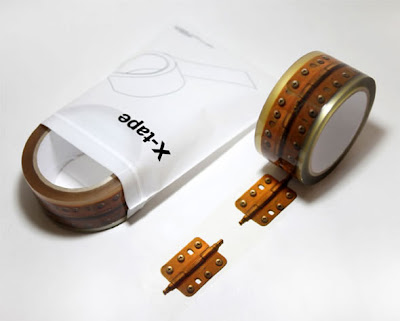Optical Illusion Hinge Tape
Product designers Hyoungmin Park and Jeongmin Lee have created a tape roll with realistic looking hinges on it. It looks pretty interesting on a box.The sun appears to expand Optical Illusion
The sun appears to expand

Expanding Lights optical illusion
When you move your head toward the image, it appear to be expanding and when u move your head away from image the image will appear to contrast

Self Potrait

Magical Mirror Anamorphoses
The Waterfall Effect
Stare at the center of the spiral for about a minute. Then, when you focus your gaze at another surface it will appear to be moving around in spiral motion. The spiralling aftereffect was first described by Joseph Plateau (1801–1883) in 1849. For a more powerful effect
The Checker Board Shadow

Face in the Beans

Look closely and find a face among the beans!
Dynamic Luminance – Gradient Effect

Sit at a comfortable distance and then move forward toward the center of the figure. You will perceive a notable change in brightness and even form — what may be called a “here comes the sun” effect. By moving back and forth, this apparent change will repeat. Created by Alan Stubbs, University of Maine, USA. See illusions and other visual effects at his website PerceptualStuff.
Rotating Snake Illusion

Otherwise known as “anomalous motion illusion”. It was created by Akiyoshi Kitaoka, professor of psychology at Ritsumeikan University, Kyoto, Japan. For a larger view, click on the image below.Otherwise known as “anomalous motion illusion”. It was created by Akiyoshi Kitaoka, professor of psychology at Ritsumeikan University, Kyoto, Japan. For a larger view, click on the image below.
The blurry heart illusion
Kohske Takahashi, Ryosuke Niimi & Katsumi WatanabeUniversity of Tokyo, Japan
Please move the eyes over the static red hearts on the blue background. The blurry heart wobbles whereas the sharp heart remains still.
The fat face thin (fft) illusion
It is well-known that faces are more difficult to recognise when they’re upside-down and that sometimes we misperceived the facial expressions of upside-down faces as is shown in ‘The Margaret Thatcher illusion’.Peter Thompson University of York, UK
Now I give you ‘The Fat Face Thin illusion’. Compare the upside-down face on the left of the lower figure with the upright face on the right. The upside-down version looks much thinner, – altogether a longer shaped face than the upright version. Of course the pictures are identical. This illusion illustrates the internal features of the face, (eyes, nose, mouth) can distort our perception of face shape.
Attention-biased after-image rivalry
Peter Tse Dartmouth College, USA
Fixate the colored image by looking at the fixation spot for about 60 seconds. Now shift your eyes to the fixation spot surrounded by rectangular outlines. If you attend to the vertical outline rectangle you will see the afterimage corresponding to it, and if you attend to the horizontal outline rectangle you will see the different afterimage corresponding to it. You can shift which afterimage you experience by attending to one rectangle and then the other.Peter Tse Dartmouth College, USA
Blivet
 A blivet, also known as a poiuyt, is an undecipherable figure, an optical illusion and an impossible object. It appears to have three cylindrical prongs at one end which then mysteriously transform into two rectangular prongs at the other end.
A blivet, also known as a poiuyt, is an undecipherable figure, an optical illusion and an impossible object. It appears to have three cylindrical prongs at one end which then mysteriously transform into two rectangular prongs at the other end. Bezold Effect

The Bezold Effect is an optical illusion, named after a German professor of meteorology, Wilhelm von Bezold (1837-1907), who discovered that a color may appear different depending on its relation to adjacent colors. In the above example, the red seems lighter combined with the white, and darker combined with the black.
Café Wall Illusion

The café wall illusion is an optical illusion, first described by Doctor Richard Gregory. He observed this curious effect in the tiles of the wall of a café at the bottom of St Michael’s Hill, Bristol. This optical illusion makes the parallel straight horizontal lines appear to be bent. To construct the illusion, alternating light and dark “bricks” are laid in staggered rows. It is essential for the illusion that each “brick” is surrounded by a layer of “mortar” (the grey in the image). This should ideally be of a color in between the dark and light color of the “bricks”.
Lilac Chaser

Lilac chaser is a visual illusion, also known as the Pac-Man illusion. It consists of 12 lilac (or pink or magenta-like), blurred disks arranged in a circle (like the numbers on a clock), around a small, black, central cross on a grey background. One of the disks disappears briefly (for about 0.1 second), then the next (about 0.125 second later), and the next, and so on, in a clockwise direction. When one stares at the cross for about 20 seconds or so, one first sees a gap running around the circle of lilac disks, then a green disk running around the circle of lilac disks, then a green disk running around on the grey background, the lilac disks appearing to have disappeared or to have been erased by the green disk.





